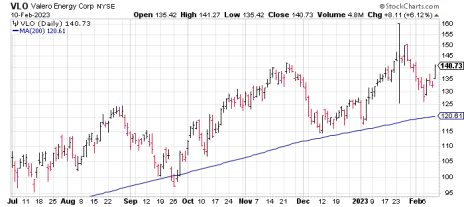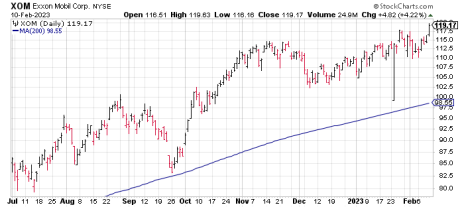Crude oil prices are down 40% from last year’s peak, providing consumers with a break from rising fuel costs. But while the oil market has remained remarkably subdued in the face of the ongoing conflict in eastern Europe, Russia reminded investors with a stark reminder that the energy sector (and oil stocks) remains susceptible to the war’s influence.
Oil prices recently jumped in response to Russia’s announcement that it would reduce its oil production by 500,000 barrel-a-day, or about 5% of output, starting in March. The move allowed the S&P energy sector to post its biggest weekly gain of the year to date.
While many observers have been focused on the depressed oil prices of the last several months, oil production and exploration companies have shown remarkable resilience during this time. Oil companies delivered the market’s best shareholder returns last year, according to the Wall Street Journal, yet investors remain reluctant to commit to the energy sector.
[text_ad]
Another consideration is China, which is widely expected to account for nearly half of the world’s oil demand this year as its economy recovers from last year’s Covid-related shutdowns.
Bloomberg has noted that China’s oil market is already making an impressive comeback in the wake of its reopening. Bloomberg analysts are predicting the industry is “on course for a bumper year” as China’s refiners ramp up output.
On a related note, Fatih Birol, executive director of the International Energy Agency, recently told attendees at an energy conference in India that China’s jet fuel demand is “exploding” and is likely to put upward pressure on oil prices.
He added, “If demand goes up very strongly, if the Chinese economy rebounds, then there will be a need, in my view, for the OPEC+ countries to look at [increasing output].”
An additional factor worth mentioning is that, despite several Western governments’ commitments to transition to cleaner alternative energy sources, the oil industry’s massive profits in recent quarters “has shown that global thirst for oil and gas remains strong,” as the WSJ observed. Indeed, industry experts are agreed that it will take years for the world to wean itself away from oil-based energy, leaving oil producers with a continued pathway to keep growing profits in the foreseeable future.
With this in mind, let’s take a look at two oil stocks that stand to benefit from an energy market rebound in 2023. Both, however, are equally committed to growing their respective footprints in the burgeoning renewable energy field, giving them exposure to both trends.
Valero (VLO) is the world’s largest independent crude oil refiner and the second-largest corn ethanol producer, making it a major player in both the oil/gas and clean energy spaces. In its Q4 earnings report, VLO reported that its earnings tripled from the year-ago quarter and rose more than 10 times for the full year. Its refining segment’s operating profit soared 230%, to over $4 billion, as it had one of its best utilization rates in years—thanks to a sizable spread between crude prices and refined fuel prices.
Meanwhile on the diesel front, Valero intends to extend its reach into renewable diesel, made from animal fats and cooking oils, as part of a plan to reduce carbon emissions. The company’s Diamond Green Diesel joint venture with agri-food processer Darling successfully started up in November, which is expected to produce over one billion gallons of renewable diesel and 50 million gallons of renewable naphtha annually. The company is in the unique—and highly desirable—position of being able to benefit from the growing demand for both oil-based and alternative energy.
ExxonMobil (XOM) needs no introduction as one of the world’s biggest publicly traded international oil and gas producers. In Q4, the company achieved its best-ever annual refining throughput in North America, and the highest globally since 2012, while delivering industry-leading 2022 earnings, cash flow from operations, total shareholder return and return on capital employed.
On the renewable energy front, ExxonMobil is advancing work on what’s expected to be the world’s largest low-carbon hydrogen production facility upon completion. The integrated ExxonMobil Baytown (Texas) facility will produce one billion cubic feet of low-carbon hydrogen per day, making it the largest low-carbon hydrogen project in the world with an expected startup in 2027-2028. Meanwhile, the company’s majority-owned affiliate, Imperial Oil (IMO), is moving forward with construction of the largest renewable diesel facility in Canada.
ExxonMobil further remains committed to shareholder returns and just increased its share-repurchase program, with up to $35 billion of cumulative share repurchases in 2023-2024 (7% of the current market cap).
[author_ad]



